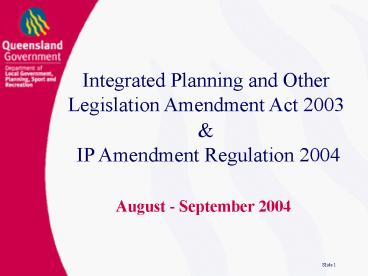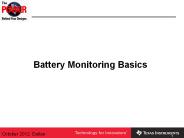IPA and IDAS Basics - PowerPoint PPT Presentation
1 / 45
Title:
IPA and IDAS Basics
Description:
... is not required for land the subject of an easement, if owner is the owner ... tenement & development is not inconsistent with the terms of the easement ... – PowerPoint PPT presentation
Number of Views:27
Avg rating:3.0/5.0
Title: IPA and IDAS Basics
1
Integrated Planning and Other Legislation
Amendment Act 2003
IP Amendment Regulation 2004
August - September 2004
2
IPOLAA 2003
3
Background
- Introduced into Parliament - June 2003
- Debated - 9th and 14th October 2003
- First provisions commenced - 16th October 2003
- Additional provisions commenced - 14th November,
19th December 2003 and 3rd June 2004 - Regulations currently being finalised
- Expected commencement date 4th October 2004
4
Overview of categories of reforms
- Community designations
- Infrastructure planning and funding
- Environmental Impact Statements
- IDAS -
- focus of this presentation
- Rats and mice amendments (most commenced 16th
October 2003)
5
Community designation reforms
- s2.6.7 - introduces a more performance based
approach to environmental assessment and public
consultation - s5.8.8 provides for guidelines for
environmental assessment - Schs 6 and 7 of the Act removed (superseded by
s2.6.7 5.8.8) - Sch 9 of the Act and sch 11 of the IP Reg. makes
certain community infrastructure exempt
development - s6.2.4 - transitional arrangements for
designations already commenced under existing
processes - Guidelines
- publicly notified in July 2004
- available from the IPA website www.ipa.qld.gov.au
- comments due by 16th August 2004
- commencement expected with other parts of IPOLAA
6
Infrastructure reforms
- Introduces a revised infrastructure planning
charging frameworks - Emphasises links between land use planning
infrastructure planning - Key elements Priority Infrastructure Plans
(PIPs) - part of planning schemes
- identifies Priority Infrastructure Area (PIA)
- basis for preparing and levying infrastructure
charges - Infrastructure charging and conditioning powers
clearly defined - Key charging element Infrastructure Charges
Schedule
CONTINUED OVER PAGE
7
Infrastructure reforms (cont)
- Introduces a simplified Regulated Infrastructure
Charges Schedule (RICS) mechanism for smaller
local governments - Introduces a revised system for recovering
additional costs for servicing unanticipated
development - Creates a framework for integrating State
infrastructure providers (Main Roads, Transport,
Education and Emergency Services) - Supported by guidelines and regulations
CONTINUED FROM PREVIOUS PAGE
8
EIS process
- New Ch 5, part 7A introduces an environmental
impact statement process applying to - - assessable development prescribed by the IP Reg
- prescribed community infrastructure on land to be
designated - Allows IPA to be accredited under the EPBC Acts
bilateral agreement - Regulations and operational arrangements to be
finalised - Will commence 4th October 2004 -
- but will only become active when the necessary
trigger is included in the IP Reg - trigger is likely to be a controlled action
under the EPBC
9
IDAS reforms
10
Preliminary matters
- Definition of terms used in development (s.1.3.5)
- Amends the definition of building work and
operational work - - clarifies that all tidal works and works for the
taking or interfering with water under the Water
Act 2000 are operational works (commenced 3rd
June 2004)
- Exempt development (s3.1.2)
- Provides for new sch 9 - lists exempt development
which can not be made assessable against a local
governments planning scheme - - replaces previous schedule 8, part 3
11
Preliminary matters
- Assessment Manager (s3.1.7)
- Provides for new sch 8A details the new
arrangements for identifying the assessment
manager for an application - - tabular format
- more user-friendly and comprehensive
- Existing arrangements deleted from IP Reg, sch 1A
- Clarifies the role of the assessment manager
- Gives jurisdiction to LG for prescribed tidal
works - - not yet active as no tidal works are yet
prescribed - Clarifies that if an agency (i.e. EPA or NRME)
is prescribed as the AM for an application and
also has referral jurisdiction the agency is
the AM for the application and has multiple
jurisdictions
12
Preliminary matters
- Ministers powers (s3.1.7A)
- Can nominate an entity that was a candidate for
assessment manager as a concurrence agency for
the application
- Referral agencies (s3.1.8)
- Clarifies a referral agencies jurisdiction for an
application - Clarifies how to determine the number of referral
agencies for an application - - an entity that might go by different names for
the purpose of exercising their referral
jurisdiction, but who in fact is the same natural
person, is taken to be a single referral agency
13
Preliminary matters
- Native title (s3.1.11)
- Amended so that IDAS stops if action /
consultation is required under the Native Title
Act 1993 (Cwlth) (commenced 16th Oct 2003)
- IPOLAA 2001
- Repeal of IPOLAA 2001 (commenced 16th Oct 2003)
- uncommenced provisions of IPOLAA 2001 were
repealed
14
Preliminary approvals under s3.1.6
- Existing deficiencies
- Difficulty dealing with development at a
conceptual level - the application must be for assessable
development - the assessment category and notification
requirements are often unclear - Difficulty dealing with layered and/or staged
approvals - limitation of application to impact assessable
MCU - Inadequate for several major proposals in smaller
local government areas
15
Preliminary approvals under s3.1.6
- Reforms
- S3.1.5 reference to assessable removed
- Significant changes to s 3.1.6 to
- broaden the range of development to which it
applies - makes a distinction between MCU and other aspects
of development - Changes to s3.4.2 to require public
notification of first stage regardless of the
assessment category - notification is not necessary for later stages if
consistent with earlier stages - Referral coordination now required for all s3.1.6
applications (s3.3.5(1)(c)) - New assessment and decision rules (s3.5.5A and
3.5.14A) for scheme modifying component of the
application
CONTINUED OVER PAGE
16
Preliminary approvals under s3.1.6 (cont)
- Reforms cont
- All s3.1.6 preliminary approval must be recorded
on planning scheme (s3.5.27) - Ministerial direction powers expanded to include
modifications under s3.1.6 - A s3.1.6 preliminary approval can not override a
State-code or sch 8 of the IPA - A s3.1.6 preliminary approval falls away once
the approved development is completed or the
approval lapses
CONTINUED FROM PREVIOUS PAGE
17
Application stage
- Applying for development approval (s3.2.1)
- IDAS application form can identify mandatory
information - Owners consent only required for applications
for - - MCU
- reconfiguring a lot
- works on land below high-water mark and outside a
canal on rail corridor land - Resource managers consent arrangements -
- instead of, not in addition to owners consent
for State land - Owners consent is not required for land the
subject of an easement, if owner is the owner of
the servient tenement development is not
inconsistent with the terms of the easement
18
Application stage
- Public scrutiny (s3.2.8)
- Simplifies clarifies requirements for public
scrutiny - New definition of supporting material
- Withdrawing an application (s3.2.11)
- Expands who receives notification of withdrawal
of an application - Makes the applicant responsible for notifying all
parties of the withdrawal of the application
(commenced 16th Oct 2003)
19
Information referral stage
- Applications in response to a show cause notice
or enforcement notice (s3.2.12) - The timeframe for responding to an information
request reduced from 12 months to 3 months
(commenced 16th Oct 2003)
- Referral coordination (s3.3.5)
- Triggers relocated from s6.1.35C into main body
of the Act - Application for 3.1.6 preliminary approval
required - The basis for the AM determining referral
coordination is not required - amended to refer
to the likely significance of the environmental
effects (not merely the significance of the
proposal itself)
20
Information and referral stage
- Concurrence agency response powers (s3.3.18)
- Reflects changes to code assessment in s3.5.13
- Corresponding changes to concurrence agency rules
when development is on designated land
- Advice agency response powers (s3.3.19)
- Reworded for consistency with AM rules in s3.5.11
21
Notification stage
- Public notification (s3.4.5)
- Clarification of public notification requirements
over the Christmas period (commenced 16th Oct
2003) - Now required for, at least the 1st stage of, all
applications for a s3.1.6 preliminary approval
22
Decision stage
- Assessment by AM (s3.5.3A)
- Distinguishes between integrated and
coordinated parts of an application - - the AM cannot assess the coordinated part
- Code assessment (s3.5.4)
- Introduces SPP as a consideration in code
assessment
23
Decision stage
- Decisions generally (s3.5.11)
- Clarifies how the AM must deal with a direction
from a concurrence agency and conditions imposed
by a concurrence agency
- Decision in relation to code assessment (s3.5.13)
- Reforms the guidance provided for decision-making
- judicial authority on the current provisions
suggests they are capable of being interpreted
more narrowly than intended - Current provisions may prevent development of
codes giving comprehensive guidance, not only
about development complying with the code, but
about development that would not comply with the
code
24
Decision stage
- Names of submitters (3.5.15)
- Provides for applicants to be notified of the
names addresses of any submitters for the
application as part of the decision notice - re-instates an arrangement under the repealed PE
Act
- When approval takes effect (3.5.19)
- Submitters may forego right of appeal by giving
the assessment manager a notice
25
Decision stage
- Compliance assessment (s3.5.31A)
- Introduced in relation to conditions only
- Sch 12 of the IP Reg details -
- process for assessment
- appeal rights
- Subdivision plans (s3.7.4)
- Provides for payment of outstanding rates and
charges for subdivision plans for development
(commenced 16th Oct 2003)
26
Decision stage
- Approvals recorded on planning schemes (s3.5.27)
- Expands the circumstances under which approvals
or decisions must be noted on a planning scheme - - preliminary approvals under s 3.1.6
- decisions to allow the application of a
superseded planning scheme for development on
premises - Requires the chief executive to be given notice
of the notation
27
Appeals, offences enforcement
- Appeals by submitters (s4.1.28)
- Clarifies the scope of submitters appeal rights -
- submitters can not appeal concurrence agency
conditions or directions
- Advice agency submitters (s4.1.29)
- Clarifies the scope of advice agency submitters
appeal rights - - advice agency submitters can not appeal
concurrence agency conditions or directions
28
Appeals, offences enforcement
- Notice of appeal (s4.1.41)
- Clarifies the list of entities to whom the notice
of appeal must be given
29
Development offences, notices orders
- Carrying out assessable development (s4.3.1)
- Clarifies that, in order for development to be
lawfully carried out under a development permit
the permit must have taken effect - - a development permit may be given, but depending
on the circumstances may not have taken effect
30
IP Amendment Regulation 2004
31
Overview
- Reformatting to -
- reflect changes in IPOLAA 2003
- improve legibility and simplify
- re-arrangement of several sections (e.g. fees)
- Several new substantive provisions -
- about 10 20 of contents
32
Schedule 1
- Prescribes the Type of Assessment and Codes, Laws
and Policies that may apply - Arranged according to -
- impact assessment
- code assessment
- code assessment unless a planning scheme requires
impact (e.g. reconfiguring a lot and prescribed
tidal works) - self-assessable (guidance only actually
prescribed in schedule 8 of the Act) - Further split up by aspects of development
- Includes applicable codes and policies
- this list is not determinative the applicable
codes and policies are determined by the relevant
Act. The list is indicative only
33
Previous schedule 1A
- Prescribed alternative assessment managers
deleted - All aspects of assessment managers now prescribed
under sch 8A of the Act - Consolidates rules for assessment managers in the
Act rather than the regulation in order to
maintain the fundamental role for local
government in the Act - Wording in s3.1.7 and schedule 8A of the Act
allows simpler wording in sch 2 of the regulation
34
Schedule 2
- Prescribes referral agencies and their
jurisdiction - Rearranged into 3 tables -
- building work assessable against SBR (easy access
for private certifiers) - development assessable under sch 8
- development assessable under a planning scheme
- Some triggers appear in more than 1 table (e.g.
Heritage) - Tables consolidated from 4 columns to 3 (referral
agency and their jurisdiction combined into 1
column)
35
Schedule 2 - new or changed referrals
- Expanded ERA triggers
- Table 2, item 20 (for simultaneous commencement
of EPOLAA 2003 mobile and temporary ERAs) - Operational works causing stormwater
concentration on State controlled roads - Table 2, item 2A and Table 3, item 2
- Upstream referrals for vegetation clearing
- Table 2, item 3 and Table 3, item 12
CONTINUED OVER PAGE
36
Schedule 2 - new or changed referrals (cont)
- Removal of quarry material under the Water Act
2000 - Table 2, item 8 (corrects previous oversight)
- Electricity infrastructure
- Table 2, item 17 and Table 3, items 9 - 11
advice referrals for development on easements and
adjoining substations - Land designated for community infrastructure
- Table 3, item 8
CONTINUED FROM PREVIOUS PAGE
37
Schedules 3 - 5
- Sch 3 (local governments that must review PIPs)
- new schedule
- Sch 4 (altered assessment periods)
- no changes
- Sch 5 (thresholds for development contiguous to a
State-controlled road) - cosmetic and minor changes only
38
Schedules 6 - 9
- Sch 6 (local government population areas)
- no changes
- Sch 7 8 (referral coordination triggers)
- current sch 6 becomes sch 7 - list has been
substantially reduced - current sch 7 becomes sch 8 changes reflect
recent integrations into IPA - Sch 9 (court fees)
- no changes
39
Schedule 10
- Prescribes the State resources schedule
- Accompanies changes made to s3.2.1 of the Act
regarding owners consent - Under s3.2.1(5) evidence is required from a State
agency prior to the making of an IDAS application
if the resource appears in the schedule - This evidence is instead of, not in addition to
owners consent under s3.2.1(3) - Owners consent for most works has been removed
in IPOLAA 2003 - The grounds on which consent may be given or
withheld are limited
40
Schedule 11
- Prescribes exempt development for community
infrastructure links with sch 9 of IPOLAA 2003 - Currently limited to network infrastructure -
- transport
- electricity
41
Schedule 12
- Prescribes compliance assessment links to new
s3.5.31A of the Act - Applies only for conditions of a DA
- The choice of whether to use this power rests
with the assessment manager for the application - Limited to local government works conditions on
MCU approvals only - future possible use for environmental management
plans - Intended as a simpler process to discourage
separate regulation or works under schemes - Has implications for schemes
42
Schedule 13
- Prescribes trunk infrastructure charge rates for
regulated infrastructure change - Contains a maximum per unit charge of 1,500.00
per network - Networks are outlined in Priority Infrastructure
Plans (PIPs)
43
Implications
- Everyone will need
- A copy of the latest version of the IPA and IP
Regulation available free from www.legislation.qld
.gov.au
- Local Governments will need to
- Establish a process and system for recording
s3.1.6 preliminary approvals on their planning
schemes - Establish a process for notifying the Chief
Executive DLGPS of any notation on planning
schemes for a s3.1.6 preliminary approval - Decide whether or not they will use the
compliance assessment process
44
Implications (cont)
- Assessment managers and private certifiers will
need to - Download the new IDAS Applications Forms, Guides
and Implementation Notes from www.ipa.qld.gov.au - Revise standard templates for acknowledgement
notices, decision notices etc - the Department will amend our recommended
notices available from www.ipa.qld.gov.au - Know when land owners consent is not required
- Understand the concept of resources manager's
consent - Revise any advice given to staff about what
material must be made available through public
scrutiny - Be aware of new and amended referral agencies
- Be aware of amendments to the schedules for
referral coordination - Be aware of schedule 11 of the IP Reg - exempt
development for community infrastructure
45
IPOLAA 2004
- Gives effect to Governments commitments to
regional planning in South East Queensland - New Ch 2, part 5A administered by Deputy
Premier Treasurer - Regional Coordination Committee
- Regional Plan prepared approved by Deputy
Premier Treasurer - regulatory component ratified by Parliament
regional landscape protection - Regional Plan will be a consideration in IDAS
until reflected in planning schemes - will also inform State and local infrastructure
planning (e.g. through PIPs)































